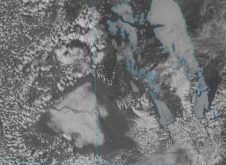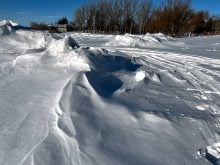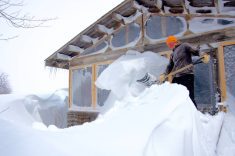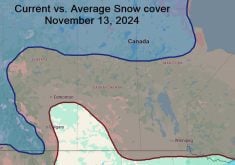The weather page is prepared by Daniel Bezte. Dan has a BA Honours degree in geography, specializing in climatology, from the U of W. He has taught climate and weather classes at the U of W, and is a guest climate expert on CJOB’s morning show with Larry Updike. Daniel runs a computerized weather station on his 10 acres near Birds Hill Park, which he plans to develop into a small vegetable and fruit hobby farm.
Daniel welcomes questions and comments at [email protected]
Read Also

June brings drought relief to western Prairies
Farmers on the Canadian Prairies saw more rain in June than they did earlier in the 2025 growing season
We started talking about clouds a couple of weeks ago by jumping into how clouds are classified. I then said that we would continue our look at clouds by examining each of the different cloud types in a little more detail, discussing just what type of weather we could normally expect with each type of cloud. We are still going to do that, but after thinking about it for a couple of weeks, I think I jumped the gun a little bit on our cloud discussion. Before we go on to examine each type of cloud, we should first take a look at the bigger picture, that is cloud formation.
To start off, just what are clouds? To put it simply, clouds are areas of the atmosphere where moisture has become concentrated enough that it is now visible to the naked eye. The atmosphere always has moisture in it, no matter how hot or cold or dry it is. This moisture is in extremely tiny droplets or ice crystals (if we can really call them that at this point), they are microscopic in size and are mixed in with molecules of air. Usually the amount and size, or concentration of moisture is not great enough for us to see, but under the proper circumstances atmospheric moisture will come together to form clouds.
For clouds to form we need to cool the air so that condensation will occur. Condensation is the process by which the tiny molecules of water in the air come together to form larger droplets or ice crystals. Without going into topics such as vapour pressure, mixing ratios, and absolute and specific humidity (we might eventually discuss these in a different set of articles), condensation occurs because, as the air cools, the ratio of evaporation to condensation tilts in favour of condensation.
Evaporation and condensation of water vapour are continuous and ongoing processes in the atmosphere. Usually, more evaporation is taking place than condensation, so, as the microscopic water droplets or ice crystals collide and grow, they quickly evaporate back to their original microscopic size. When we cool a parcel of air enough, the amount of evaporation that takes place decreases because evaporation takes energy that comes from heat. Now, as the microscopic water droplets or ice crystals collide and grow, they do not evaporate as quickly. As more and more collisions occur they eventually grow big enough to become visible – they have grown large enough to be called a cloud droplet.
When talking about the size of these cloud droplets we are talking about drops of water that range in size from around five microns up to around 50 microns (one micron is one-millionth of a metre, so these are some really small drops of water). Another way to compare the size of cloud droplets is that it takes about one million of them to make a raindrop. This is why clouds (or the water in them) don’t fall out of the sky. The cloud droplets are so small that they only fall at a rate of about one centimetre a second or about 0.04 km/h. So it doesn’t take much of an updraft to keep these tiny droplets airborne.
I jumped a little ahead of myself again here. I talked about condensation allowing lots of microscopic water and ice crystals to grow, but I never discussed all the collisions occurring between these microscopic water and ice crystals. There are two main processes that allow for clouds, rain, and snow to form – the collision-coalescence process and the Bergeron process. The first of these processes is fairly self-explanatory. The microscopic water droplets collide and combine (coalesce). With each collision the droplets get larger, eventually becoming visible and possibly even a raindrop.
The second process, the Bergeron process, happens with ice crystals. Here ice crystals grow because they absorb water vapour more readily than water droplets. That is, in a cold cloud, water droplets can be super cooled below the freezing point and still remain liquid; if an ice crystal is near one of these super-cooled water droplets the ice crystal will absorb the water from the water droplet by causing the water droplet to evaporate while the ice crystal uses this newly evaporated water to grow.
OK, so now we know that clouds form when atmospheric moisture condenses into droplets (or ice crystals) that are large enough to be visible to the naked eye. We also know it requires that the air be cooled so that condensation occurs more rapidly than evaporation. Now I feel we are ready to move on to our look at the different cloud types – but that will have to wait until next time.



















